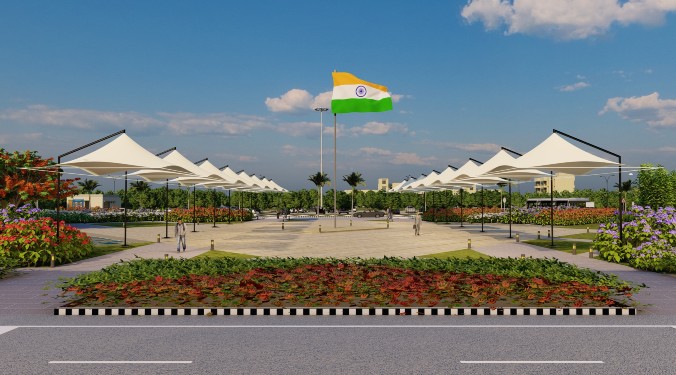“Architect forms a shelter out of an idea about the use, subdivides the space and develops the plan for relations among the assemblies,” remarks Sriniwas P. Anchuri, Architect and Structural Engineer, Anchuri & Anchuri
The architectural profession is changing, and artist, architect, and structural engineer Sriniwas P. Anchuri is hopeful about the future of architects in India. In an exclusive interview with ACE Update, he shares how he and his wife started their practice in a small space and transformed into a premium architectural firm.
Architecture and IndiaArchitecture profession is gaining unprecedented acceptance in India, not only in India but all over the world, especially in developing countries. It is an exciting, broad-based and challenging profession, and the role of an architect is evolving today at an exceptional rate. Architectural practices are applied to building design and construction in today’s fast-paced, ecologically responsible and cost-driven construction industry.
Architect forms a shelter out of an idea about the use, subdivides the space and develops the plan for relations among the assemblies. When the aspiration pushes beyond simple utility of building to architecture, it is the architect who pushes the assemblies and their joints by massing, shaping, surfacing and profiling. Architecture requires deep control, not merely of an idea but also the substance an architect uses to give form to the idea.The use of materials in architecture is rarely more than a stylistic statement made in an effort to claim modernity merely through the use of an innovative product. Novelty alone cannot sustain use. Sustainability movement in architecture is gaining tremendous momentum every year. Still the industry needs hard information about the planning, design, products and methods for sustainable structures.
In India, apart from thought process, the age at which the people are thinking of having their dream home has changed. The change can be seen not only in their use of communication device which anyone can clearly see. How have the smartphones come and how have we shown exit to telegram from the country? Right from the home to working place, we have changed .There is a sea change in our day-to-day requirements. In urban life, working women percentage has increased.
Journey in architectureArchitect S. P. Anchuri has started his practice 18 years back in Hyderabad with his wife, Chamundeshwari Anchuri, in a small space. They used to call it “office cum residence” not “residence cum office”.
In those days, their average clients’ age group was 55 to 58 years who used to come to them for getting their dream home designed and built with their retirement benefits for their children and grandchildren. Slowly the age of client went on reducing and in 2005 it came down to 45 years and requirement was for their teenage children. With the rapid growth in information technology and industrial developments, age group came down to 30 years. Now the requirement is for their parents being their child. The fast development in material science and process engineering on one hand and on other side information technology, availability of any kind of information at single click, global became local. Now people are thinking to have their home at the time of appointment letter itself.
Is it to explain about the very rapid change of mind set. Anchuri & Anchuri, at their office, continuously keep themselves updated. The firm has grown multifold with more than 10 associated consultants. S. P. Anchuri, being one of the rare combinations in India, i.e. an architect and structural engineer by education and practice, delivered very eco-consciously designed buildings to the society. His wife helps him in achieving eco-conscious designs of buildings through integrated approach. Her contribution, especially in architectural design, is tremendous.
X-FactorsThe architectural profession is changing. Globalisation and unpredictably prove dominant forces in architectural profession and architects must address X-factors.
S. P. Anchuri has defined a number of factors that could better position Anchuri and Anchuri within the market, principally by producing diverse, eco-conscious designs. To achieve this, he has defined X-change as the central goal in addition to knowledge X-change and social X-change and trying for Capacity Pull X-factors, Media Fascination X- factors, Professional Hold X-factors.
A firm — whether big or small — can compete with technology. Creating a document source, following highlights and team up can be done effectively and affordably especially by delighting the team.
Architects and designers have a responsibility to the built environment and the natural world. Not only they design for clients but as a social responsibility help others through various forums by open communication, constructive dialogue, television programmes and leading magazines by sharing research, data and ideas.
He has recently constructed his own home which is a net zero building. They enjoy every second of the 24 hours of the day. The same feeling they are trying to give to their clients in their building design. Pyramids, sky lights and central court yards are a prime factor in their designs. In group housings they have achieved no common wall concept for each apartment without compromising the built-up area.
Achievements in 2014In 2014, Anchuri and Anchuri did many projects which include educational institutions, malls, residential and commercial buildings, ashram and auditorium.
The current objectives towards sustainable buildings and architectural design are leading to new challenges for the construction industry in coming years. The lifecycle design approach, which take into account all the aspects of construction practice from design, construction and service life management, to demolition and the recycling of materials is the best approach today.
Especially in Hyderabad after the formation of two states Telangana and Andhra Pradesh, people are there are living through a period of great change — specifically a great challenge — in which we can also see changes in the central goals and requirements of construction techniques. Anchuri and Anchuri is adapting precast technologies, prefabrications, alternative materials and alternative structural systems for fast-track constructions. The firm finds its good role in both states, especially in 2015. It has recently established office in Vizag to cater Andhra Pradesh.
Expectation in 2015The focus at Anchuri and Anchuri this year will be to cater its clients through a new model of integrated life-cycle design, keeping in mind the life-cycle costs, life-cycle environmental impact, design of reuse and recycling, service life design, durability design by achieving optimisation with the use of international and national standards, and computer tools and rank among the highest in architecture professionals.
7
Cookie Consent
We use cookies to personalize your experience. By continuing to visit this website you agree to our Terms & Conditions, Privacy Policy and Cookie Policy.









